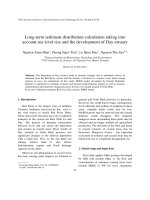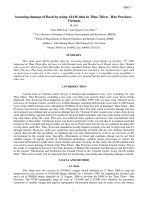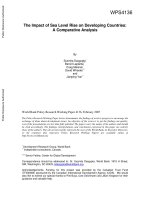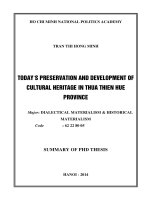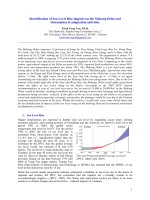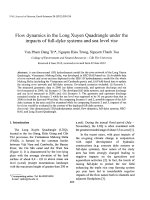Preliminary assessment of sea level rise impacts tocoastal ecosystems in thua thien hue
Bạn đang xem bản rút gọn của tài liệu. Xem và tải ngay bản đầy đủ của tài liệu tại đây (397.21 KB, 12 trang )
VNU Journal of Science, Earth Sciences 28 (2012) 140-151
Preliminary assessment of sea level rise impacts to coastal
ecosystems in Thua Thien - Hue
Le Xuan Tuan*
Research Institute for the Management of Seas and Islands,
Vietnam Administration of Seas and Islands, MONRE
No34A, Alley 84, Chua Lang, Hanoi, Vietnam
Received 9 March 2012; received in revised form 22 March 2012
Abstract. Coastal ecosystems such as estuaries, lagoons, gulfs, mangroves, coral reefs, sea grasses
support high productivity and biodiversity in Viet Nam. The coastal ecosystems play a crucial role
not only in biodiversity reserve but also in socio-economic and local residents’ daily life. In the
setting of increasing affection of climate change, researching impacts of sea level rise to the
coastal ecosystems is necessary. This paper provide picture of coastal ecosystems and assessment
of sea level rise impacts on the ecosystems in Thua Thien – Hue. In this study, climate change
vulnerability is applied as methodology for the assessment. The focused factors caused by sea
level rise include inundation, flood, erosion, wetland loss, and increased salt water intrusion. The
analyses show that, sea level rise has different impact on communities in the coastal areas in Thua
Thien Hue. Among them, seagrass communities in the lagoons seem to be more vulnerable
compared to the others.
Keywords: sea level rise, coastal ecosystems, vulnerability, adaptation, lagoons
1. Introduction∗
drought over recent decades. Asia, which
consists of Vietnam, has to face sea level rise
hazard. According to research by the World
Bank, Vietnam shall be one of two developing
countries (Vietnam and Bangladesh) to be the
most seriously impacted by sea level rise. Most
of the flat lands would be inundated, agriculture
as well as GDB are also affected badly
(Dasgupta et al., 2007) [1]. According to
Pilgrim (2007) [2], in Vietnam, 1 meter sea
level rise will impact on 78 important nature
reserves (27%), 46 natural conservations (33%),
and 23 nature conservation sites consisting of 9
Natural resources are human development
and vital foundation no matter what age, region
or race in the world. Global climate change has
the clearly negative impacts on natural
resources all over the world. Climate change
exposes numerous problems to every nation.
Climate change increased extremely events
such as typhoon, heavy rain, rising heat,
_______
∗
Tel: 84-4-32595432.
E-mail:
140
L.X. Tuan / VNU Journal of Science, Earth Sciences 28 (2012) 140-151
141
main biodiversity areas (21%). In Viet Nam,
local people much depend on these natural
resources.
conducted. The research results would provide
the foundation to serves biodiversity
conservative implementations.
Simultaneously, climate change scenarios
for Viet Nam developed in 2009 have been
brought out until 2010, and base on that, the
most optimistic scenario considered 0,65 m of
sea level rise, meanwhile, this interval in the
worst one is 1,0 m. In that context, research as
well as assessing impacts of sea level rise to
coastal ecosystems in Thua Thien – Hue, where
is proposed Hon Hai Van-Son Tra Marine
Protectd Area located in the region between
Cau Hai lagoon (in the south-west of Thua
Thien Hue) and Da Nang Bay, has been
The IPCC concept of climate change
vulnerability is applied in order to analyze
impacts on ecosystems [3]. Climate change
vulnerability is “The degree to which a
system is susceptible to, or unable to cope
with, adverse effects of climate change,
including climate variability and extremes”.
Vulnerability is a function of the character,
magnitude, and rate of climate variation to
which a system is exposed, its sensitivity, and
its adaptive capacity (or inadaptive capacity)
(Figure 1).
Figure 1. Main component of vulnerability.
Exposure and sensitivity are ‘negative’
components that describe the potential impacts
of climate change. Exposure to a specific
climate change driver depends on following
factors: the extent to which the species’
geographic and depth range overlaps with the
climate change driver; and, the extent to which
the climate change driver affects the habitats
and ecological processes upon which the
species depend.
Sensitivity is a ‘negative’ component where
high sensitivity equates to increased potential
impact from climate change. The sensitivity of
species/communities to a climate change driver
depends on its ability to resist or adapt to
change. A rare species has a small population
and may lack genetic variation. Smaller
populations are more sensitive to pressures as
they have fewer individuals or ‘chances’ to
cope with climate change drivers. Secondly,
their lower abundance means a lower net
reproductive output. This reduces the species’
ability to recover from climate change related
mortality. Some species may be restricted to a
particular habitat as these provide the species
with necessary resources such as suitable prey
or refuge from predators. These species may not
be able to compete effectively in other habitats
whereas more flexible species are able to
exploit alternative habitats should one habitat
142
L.X. Tuan / VNU Journal of Science, Earth Sciences 28 (2012) 140-151
type be adversely affected. Species with high
habitat specificity have high sensitivity.
Sensitivity to sea level rise and other drivers is
ranked as low, moderate or high.
Adaptive capacity is a ‘positive’ component
that describes a species’ ability to acclimate or
accommodate change. High adaptive capacity
means that a species is able to more readily
accommodate change, which reduces the
potential impacts from climate change drivers.
Accommodation
may
occur
where
physiological or behavioral responses result in
acclimation or compensation that allows the
species to be successful in the new conditions.
This is the opposite of the other two
components of vulnerability (exposure and
sensitivity), which are ‘negative’ components
and the higher they are, the greater the potential
impact.
In this study, main methods/tools will be
applied as follows:
♦ Overview information about the method,
the sensitivity, adaptability of ecosystems/
species;
Collation and analysis of existing data,
and supplementary investigation on ecosystems,
species in study site;
♦
♦ Assessment
of impacts of sea level rise on
ecosystems based on the concept of climate
change vulnerability.
2. Coastal ecosystems in Thua Thien Hue
Along the coast of Thua Thien – Hue,
typical ecosystems include lagoons, sea grass
beds, coral reefs, mangroves, sandy bars, and
other ecosystems such as agricultural
ecosystems (Figure 2).
Figure 2. Coastal habitats in Thua Thien Hue.
L.X. Tuan / VNU Journal of Science, Earth Sciences 28 (2012) 140-151
Sand bank includes a system of sand dunes
and modern beaches prolong 102km from Cua
Viet (Quang Tri) to Tu Hien (Thua Thien Hue).
The sand dunes and beaches act as a wall
between the sea and lagoon systems (Thua
Thien Hue People Committee, 2002). The
sandbar between the sea and lagoon, stretching
over 70 km length, is connected to the existence
of lagoon ecosystems in the past thousands of
years. The semi-inundated area is subject to the
direct influence from sea level, tide and wind.
In this areas, some brush species, e.g. Acanthus
ilicifolius, Cerbera manghas, Clerodendron
inerme, Thespesia populnea, Melaleuca
leucadendton, Pandanus tectorius Soland,
Pandanus odoratissimus etc., may survive. The
coastal sandy wetland is less influenced by
tides, but prone to saline intrusion, and the
ground is characterized by tight soil. This is the
favorable area for some species such as
Acanthus ilicifolius, Clerodendron inerme,
Melaleuca leucadendton, Melastoma affine D.
Don , Rhodomyrtus sp, Pandanus tectorius
Soland, Pandanus odoratissimus, etc. Sand
dunes and sand turfs make up a huge proportion
of the coastal area of Thua Thien Hue, and may
be a habitat for Rhodomyrtus tomentosa,
Cactaceae spp, Ormosia pinnata (Lour.) Merr.
Ageratum conyzoides, Celtis sinensis, … some
timber plants, such as Barringtoria acutangula,
Ricinus communis, Hibiscus tiliaceus, Heritiera
litoralis, Premma integriolia, may also be
vital… However, the plants in biggest coverage
are of exotic species, e.g. Acacia auriculiformis
A.Cunn, Acacia mangium Wild, Acacia
orassicarpa A.Cunn ex benth.
There are two major lagoon systems in
Thua Thien Hue: Tam Giang - Cau Hai and
Lang Co. The Tam Giang - Cau Hai (TG-CH)
lagoon system (largest lagoon in Vietnam)
located within coordinate 16014' - 16042' N and
143
107022' - 107057' E, elongating 70km from
Phong Dien to Phu Loc with total area is about
21,620 ha, the widest is 10km and the
narrowest is less than 1km. The Tam Giang Cầu Hai lagoon is semi-closed, connect to the
sea through 2 mouths Thuan An and Tu Hien.
Lang Co lagoon is known as the Lap An
lagoon, which located in the north of Hai Van
Pass with an area of about 1,500 ha and water
provided by rivers originating from the northern
side of the Hai Van Pass. Lang Co lagoon is
connected to the sea through a mouth. On east
and south of Cau Hai lagoon and around Lang
Co lagoon, original rock (granite and gabro) is
covered along shoreline. The remaining shore
of Tam Giang Cau Hai lagoon is constituted by
loose sediment. Behind the Tam Giang - Cau
Hai lagoon systems, coastal flat shoreline
topography is a little differentiation with
common altitude from 3 - 6m, and highest point
does not exceed 10m (Thua Thien Hue People
Committee, 2002). There is swamp with
altitude less than 1m covered by pasture, with
some areas used for growing rice one crop. In
the lagoon shore appears terrace type
discontinuously, 1m in height and flooded in
the rainy season likely warp flats in south of
Thuy Tu. The bottom topography of the lagoon
is relative flat, depth ranges from 0.5-2m, and
the deepest near Thuan An mouth is 5-6m.
Sediment structure of the bottom is mostly
sandy mud or muddy sand. Based on difference
and ecological function, 8 types of habitat were
selected and specific described as following:
♦ Agricultural land where growing rice
irregularly with area of 1,648.96 ha (6.94%
total of the lagoon) mainly distributed in O Lau,
Huong, Truoi - Dai Giang river mouth area and
around the lagoon.
♦ Swamp with mangrove, with area about
3ha (0.01%) and most in Tan My area (Thuan
144
L.X. Tuan / VNU Journal of Science, Earth Sciences 28 (2012) 140-151
An town, Phu Vang district) and Ru Cha
(Huong Phong commune, Huong Tra district).
♦ Warp flat with grass flooded in rainy
season, with area 1408.5 ha (5.93%),
distributed in southern Thuy Tu.
♦ Tidal flat, with area 599.08 ha (2.52%)
distribute around Sam and Thuy Tu.
♦ Water grass bed, area about 11,420.44 ha
(48.08%) mostly distributed in around basin of
the lagoon to depth of 1m or 1.5m.
Muddy bottom, area is about 711.92 ha
(2.99 %), distributed in basin of the lagoon and
Dai Giang river mouth area.
♦
♦ Bottom is sandy mud, area 3673.67ha
(15.46%), distributed in around the lagoon
mouth.
Aquaculture ponds area is 4287,44ha,
occupied 18.05% total area of the lagoon, and
distributed in almost districts around the lagoon
but more concentrated in Dam Sam and Cau
Hai.
♦
The salinity at Lang Co always maintains at
high level. There are nearly 200 phytoplankton
species of five algae phylums, i.e. Cyanophyta,
Rhodophyta, Bacillariophyta, Pyrrophyta and
Chlorophyta in the lake. Marine aquatic species
are dominant, but their structure changes from
season
to
season.
Similarly,
marine
zooplanktons, in addition to 33 brackish water
species, are overwhelming. 32 benthos species
and crustaceans dominate in terms of species
number, while the mollusks dominate in terms
of the number of individuals, including some
high-economic value species such as blood
cockles, green mussels, estuarine oysters, mud
crabs, etc. 115 fish species, of which 20 are of
high economic values and great production,
have been recorded. The freshwater organisms
are only found in flooding season at estuaries as
lower-basin of Bach Ma.
In results of investigation, there are about
15 mangrove species in Tam Giang Cau Hai
lagoon are Avicennia mariana, Rhizophora
apiculata, Bruguiera sexangula, etc. The main
function of mangrove is scenery, habitat of
waterfowls as well as protection of shoreline.
Mangrove plants, which are mainly distributed
at the estuaries of Hoi Mit and Hoi Dua, south
of Lang Co swamp, have 28 species, 26 genes,
22 families, notably Rhizophora apiculata,
Arucennia lanata, Sonneratia caseolaris,
Aegyceras corniculatum, Excoecaria agalocha,
etc. The narrow topography, short and steep
rivers contribute to the small coverage of
mangroves. Moreover, the boom of shrimp
ponds and formation of a road around the
lagoon, combined with poor water exchange
since the road was constructed, have hampered
the mangroves growth and area expansion.
According to Nguyen Van Tien (Ed.)
(2000) [4], the species of seaweed found in
Thua Thien – Hue consists of Halophila
beccarii, H. Ovalis, Thalassia hemprichii,
Halodule pinifolia, Zostera japonica, Ruppia
maritima. In addition, we have found 9 species
of fresh water plant with high biomass and 2
seaweed species Hydrilla verticillata and
Valisneria spiralis used to as a food for fresh
fishes. Since the distribution of aquatic plants is
closely related with salinity in the lagoon, it
therefore may divide into different ecological
groups that correlate to changing in salinity.
Seagrass and other water plants cover almost
surface water area. They grow at depth of 0.7m
to 2m; however, different sub-zones have a
different distribution of aquatic plant. The
salinity increased result in fresh water grass was
died and replaced by sea grass. The survey
result estimated that there are about 1800 ha of
sea grass in Tam Giang - Cau Hai lagoon.
According to Do Cong Thung’s (2009) [5]
estimation, there are about 1000 species living
in the Tam Giang - Cau Hai lagoon, among
L.X. Tuan / VNU Journal of Science, Earth Sciences 28 (2012) 140-151
them 938 - 953 species have been named.
Probably this lagoon was the most fully study.
Phytoplankton has the highest in number of
species (287 species), fish (215 to 230 species),
bird (73 species), zooplankton (72 species),
benthos (193 species), seaweed (46), higher
plant (31), and water grass (18) (of which 7 are
sea grass species). At Tam Giang – Cau Hai,
there are 230 fish species, belonging to 65
families and 16 orders. 65% of these species are
marine finfish, 19.2% are brackish. These two
groups are of wide distribution and found in
both rainy and dry seasons. The endemic
species include Cyprinus centralis and 20 other
species of high economic value. Among 73 bird
species, there are 34 migrant species such as
Fulica atra atra, Anas poecilorhyncha, Anser
anser, Tringa erythropus, Anas querquedura
with tens of thousands individual often
observed at the estuaries of O Lau and Sam
rivers, as well as Sam lake, from November to
March. Out of these, one species is listed in the
Red Book is Limmodromus sémipalmatus, and
30 others listed as endangered species and
subject to strict protection by the EU, such as
Ardea purpurea manilensis, Pandion haliaetus
haliaetus, Falco tinnunlus interstinctus, etc.
Thus, coastal ecosystems in Thua Thien
Hue have the great ecological value and
typically represent for Vietnam lagoon
ecosystem. There are typical sub-ecosystems
here also represented for Vietnam Central
Middle, such as sub-ecosystem of sand dune,
sea grass and mangrove sub-ecosystem, and
well-off estuaries.
3. Sea level rise impact to coastal ecosystems
at Thua Thien Hue
According to Nicholls (2003) [6], the most
of impacts are broadly linear functions of sealevel rise, although some processes such as
145
wetland loss show a threshold response and are
more related to the rate of sea-level rise, rather
than the absolute change. Most existing studies
have focused on one or more of these factors:
(1) inundation, flood and storm damage, (2)
erosion, (3) wetland loss, and (4) increased salt
water intrusion. The annual sedimentation Tam
Giang lagoon is around 2.4 mm. The deposition
of sediments at Cau Hai has been at the rate of
1-1.4 mm annually since Tu Hien became the
secondary gate. Without annual sedimentation
of no more than one millimeter from dunes,
islets, and mud flats, the lagoons will be filled
up only after 1,500 years. In case of 2.4 mm
sedimentation per year from rivers, islets and
dunes, the time to fill up may be just 600 years
(Tran Thi Tuyet Mai, 2005) [7]. Based on the
scenario until 2100, our estimates of sea level
rise for Vietnam are as below:
- Sea level rise by 50 cm (sometime
between
2070
and
2080):
average
sedimentation is 0.63 – 0.76 cm/year;
- Sea level rise by 75 cm (sometime
between
2080
and
2100):
average
sedimentation is 0.78 – 1.05 cm/year;
- Sea level rise by 100 cm (around 2100):
average sedimentation is 1.1 cm/year.
Mangrove ecosystem
Mangroves and salt marshes are within the
intertidal zone of low energy coasts and are
highly sensitive to rising sea level. Mangrove
trees are adapted to being inundated salt-water
but only in some extent within physiological
capacity. Sea level rise can cause mangrove loss
and changes to intertidal wetland communities
depending on a range of interacting factors,
including geomorphologic setting, tidal range,
sedimentation, subsidence, tree growth rates
and species composition. Ellison AM and
Farnsworth EJ (1996) [8] indicated that as the
frequency and duration of inundation increases,
146
L.X. Tuan / VNU Journal of Science, Earth Sciences 28 (2012) 140-151
growth of trees will decline and forests may
retreat landward. Geological records indicate
that previous sea-level fluctuations have
created both crises and opportunities for
mangrove communities, and they have survived
or expanded in several refuges.
Mangrove plants, scattered along the banks
of lagoons, may be destroyed by rising sea
level. Due to the limits set by infrastructure
works and small coverage, the possibility for
their recovery and expansion is low. As
commented, the sedimentation speed in these
areas is slower than sea level rise, even when
the sediment-containment capability of
mangrove plants is better than tidal mudflats.
Ru Cha, located near Tam Giang lagoon, is
a low-lying place where mangroves coverage is
rather good. Adjacent to mangrove plantation
are ponds and short-term agricultural plant
areas. When the sea level rises, the mangroves
may penetrate into the shore, if there are no
works in the surrounding areas set up to prevent
water exchanges with the lagoon waters (e.g.
pond/paddy field).
Mangrove areas near Lang Co are situated
on relatively elevated platforms, and separated
with the lagoon by a surrounding road. A
majority of the mangroves are 0.5-0.7 meters
lower than the road surface, and the rest is
limited by railway and mountains. Since the
road was built, the tides flow in and out the
lagoon through an estuary and some sluice
gates. For this reason, the development and
growth of mangroves are somewhat influenced.
When the sea level rises, and with an
hypothesis that the road is made higher than
present, the mangrove area may become a
‘man-made lake’ suffering from inundation
over longer time and thus make mangrove
plants die gradually. This area is limited by
infrastructure development, so mangroves
cannot be expanded by seed scattering.
Figure 3. Inundated level follow the 50cm and 100 cm scenarios at Thua Thien Hue.
L.X. Tuan / VNU Journal of Science, Earth Sciences 28 (2012) 140-151
Corals
Sea levels are one of the factors to control
coral distribution. Most coral reef communities
are expected to be able to keep pace with
projected global sea-level rise. Brown, 1997 [9]
mentioned that, reef accretion rates range from
1-10 mm per year in average. But reef systems
may be able to build upward around 20 mm per
year, when they are growing in water depths of
less than 20 m where there is abundant sunlight
for photosynthesis. Some reef communities
may experience mortality as a result of relative
sea-level rise. Due to the slowing effect of other
factors on growth, there is the potential that
coral populations might be left behind by rapid
sea level rise. Ove Hoegh-Guldberg et al.
(2007) [10] mentioned that previous reviews
have all concluded that these changes in sea
level are relatively slow when compared to the
rate at which corals are able to grow (up to 20
cm per year for branching coral in Great Barrier
Reef), and hence do not represent a major
challenge for healthy coral populations.
If assuming that the coral reef development
in Vietnam is similar to that at the Great Barrier
Reef, and sea level rises by 100 cm between
now and 2100, coral reefs in North Hai Van
may keep up with projected sea-level rises. It is,
nevertheless, notable that the reef coverage is
still low and on the verge of decline, and this
adversely impacts the development of reefs and
their adaptability to sea level rise and other
harmful factors of climate change.
Plankton
Sea level rise will lead to change of nutrient
and salinity within the lagoon, linked to
saltwater – freshwater interface. Changing
nutrient inputs to the water column will affect
planktonic species and communities to some
147
degree. Diatoms are likely to be particularly
responsive to changes in nutrient availability.
Zooplanktons are not directly affected by
nutrient enrichment. The plankton community
will adjust to changes in nutrient inputs and
availability by changing its composition. For
that reason, at different sensitivity, the
vulnerability to sea level rise is not so high but
there will be clear changes in distribution and
density of phyplanktons and zooplanktons.
Sea grass
Björk Mats et al. (2008) [11] in dictated that
rising sea levels may adversely impact sea grass
communities due to increases in water depths
above present meadows (thereby reducing
light), changed currents causing erosion and
increased turbidity and seawater intrusions
higher up on land or into estuaries and rivers
(favouring land-ward sea grass colonisations).
It can be seen that, all seagrasses in the lagoons
in Thua Thien Hue will be exposed to changes
in sea level and therefore a reduction of light
penetration and habitat availability. Seagrass
distribution is usually limited by light
penetration. Increased water depth caused by
sea level rise will further attenuate light
penetration to seagrass. All seagrasses are
capable of responding to light reductions by
altering their physiological capacity and
morphological structure. However, at the depth
limit, the meadows are already at the extreme
edge of their light tolerance range and are
unlikely to adapt to further light reductions. For
shallower seagrasses some response to reduced
light availability is certain. This is likely to
include reduced growth and biomass. The sea
level rise by 50 cm leads to 50% reduction of
diffuse light, and 30-40% reduction of seagrass
growth. Estuarine seagrass species exposed to
brackish water, such as Ruppia sp., are tolerant
148
L.X. Tuan / VNU Journal of Science, Earth Sciences 28 (2012) 140-151
to the salinity of some 10‰ but they will be
vulnerable if the salinity exceeds 45‰ (Dang
Ngoc Thanh and Nguyen Huy Yet, 2009) [12].
Seagrasses could colonise newly inundated
lands;
however,
inappropriate
coastal
sediments, rocky shores or other barriers will
limit the capacity of seagrasses to colonise. The
simplest outcome would be for the meadow
to migrate up slope the same distance that
the lower edge was lost (no net loss of
seagrass habitat or biomass) however we do not
believe this is likely in many cases (Waycott et
al., 2007) [13]. As mentioned above, the
seagrass species are distributed near or over
islets, and close to shorelines of Thua Thien
Hue province. The species attached by fixed
roots to the bottom in the submergence
condition, mainly distributed at the depth from
0.5 – 2m. Because of this, if the sea level rises
by 50-100 cm, the seagrass bed will be heavily
influenced. Without statistics of seagrass bed
distribution by depth, we cannot calculate the
damage levels of seagrass beds that are two
meters under the surface. The growth of
seagrass at 1.5 m or deeper, will be subject to
30-40% damage if the sea level continues to
rise by additional 50 cm. If submerged deeper
(75-100cm), the grass bed slows down in its
development. Sea grass beds in these areas may
be tolerant to wider range of salinity, from 532‰. The euryhalines including Halophila
ovalis and Zostera marina may survive within
the range of 5-34 ‰ salinity. When the salinity
is lower than 5‰, their growth is adversely
affected. The salt intrusion, therefore, does not
generate major impacts on seagrass growth in
Thua Thien Hue.
Macroalgae
Intertidal species of macroalgae are likely to
expand in area in response to sea level rise
due to colonisation of newly available
substrate. Reduced light levels at deeper depths
may shift the distribution of deeper-water
species. High rates of colonisation, growth and
reproduction will, together with high
biodiversity of turf species, reduce the
vulnerability of all macroalgal groups to sea
level rise. According to Truong Van Lung and
Vo Thi Mai Huong (2005) [14], in dry season,
the optimal conditions for seaweed growth in
Thua Thien Hue lagoons are 15-25% salinity
and 20-280C temperature. At 40 cm underwater,
seaweed photosynthesis is most intense, even
more than the 20 cm column. At 60 to 80 cm
column, the photosynthesis intensity is lower
than that at 80 cm. However, since seaweed and
macroalgae may float on the water surface
regardless of level, the adaptability of
macroalgae is relatively high. For this reason,
vulnerability of macroalgae to rise in sea level
is low.
Benthic
Seasonal salinity and uneven distribution of
this factor from place to place is a typical
feature of the lagoon environment. As a result
of sea level rise, intertidal/lagoon communities
will be impacted by physical loss of habitat in
some areas and more frequent storm events, but
perhaps also with expansion of habitat in other
areas. Data derived from the mid to late
Holocene record of a southeastern Australian
lagoon indicates that sea level fluctuations and
associated changes in sedimentation caused
community change in estuarine and intertidal
environments, with a shift from dominance by
molluscs and foraminifera to charophytes,
associated with a sea level drop and closure of
the lagoon (Pat Hutchings et al., 2007) [15].
However, the different adaptability to salinity
among species is determinant to the changes in
L.X. Tuan / VNU Journal of Science, Earth Sciences 28 (2012) 140-151
distribution and composition of species in
places where salinity fluctuates. Freshwater or
slightly brackish water groups (to 5‰) include
shellfish species under Amphipoda, Isopoda,
Tanaidacea, and Brachyura, insects under
Odanata, snails (Sermyla sp., Semisulcospira
sp), clams (Corbicula sp.) and Tylorhynchus
hetoropoda. The strong brackish water species
(5-25‰) include most of the Polychaeta species
(except
for
Tylorhynchus
hetoropoda),
Alpheidae, gastropods of Neritidae and
Potamididae, and bivalves of Tellinidae,
Anomiidae, Mactridae and Solenidae (Pham
Dinh Trong, 1997) [16]. Thus, their
vulnerability is not high.
Birds
Both rising sea level and altered rainfall
patterns will influence seabird reproductive
output through the effect they have on the
availability of breeding habitat. Sea level rise
will alter erosion and deposition patterns that
will cause significant changes in the
distribution and abundance of specific
vegetation types. Based on this, sea level rise
and changing rainfall patterns are likely to
impact the majority of seabird breeding
colonies within region in some way. However,
these are longer-term processes that are unlikely
to have consistently negative impacts. Due to
influences of rivers, there exist an ecological
sub-system (estuarine) in Tam Giang – Cau Hai
lagoon, which is highly nutritious, of low
salinity and therefore suitable for the
development of salt marshes and submerged
plants, and this is a habitat for northern
waterfowls to migrate in winters. Grassy
marshes and estuarine flats during winter are
grounds for migratory birds, even in the number
of tens of thousands individuals (Tran Duc
Thanh, 1997) [17]. Due to sea level rise and
socio-economic activities, the habitats are being
149
reduced in their area and suffer to some impacts
with average vulnerability.
Salinity change in the lagoon and intertidal
areas
Flora composition in the lagoon consists of
12 freshwater species (8.93 %), brackish and
slightly brackish (12, 34), typically brackish
0.85, highly saline (15-30‰) 72.76% và marine
5.1%. Phytoplankton species make up 78.36%,
among which 171 are marine and 19.29% are
freshwater species. Inside the lagoon, at 10%
salinity are 25 species and 5% - 6% species.
When the salinity is artificially reduced, marine
phytoplanktons are destroyed and replaced by
freshwater ones, and their biomass descends.
Regarding aquatic grass, there exist 11 species,
including those tolerant to high salinity (2330‰) such as Hylaphylla ovalis and Halodule
tridentata, brackish environment (7-20‰) such
as Ruppia maritima and Halodule beccari and
high
salinity
(15-30‰)
Cymmodocea
rotundata. Salinity lower than 10% hampers the
growth of these species, and when the water is
fresh they suffer from mass mortality and are
gradually replaced by Valisneria spiralis (at
<5%) and Najas indica (0-25%). The changes
of sea grass beds subsequently result in
changing distribution of herbivorous animals,
mostly fish (Truong Van Lung, Vo Thi mai
Huong, 2005) It can be seen that, climate
change and sea level rise will be able to cause
the change of salinity in the lagoon; and
consequently, they will result in the change of
fauna and flora communities in the lagoon.
4. Conclusion
Sea level rise would affect Thua Thien Hue
coastal ecosystems and the dominant reason is
the increasing inundation at different levels.
150
L.X. Tuan / VNU Journal of Science, Earth Sciences 28 (2012) 140-151
Salinity and salt intrusion changes also cause
the changes in distribution, composition and
density of some marine aquatic species
communities. Due to adaptive ability to sea
level rise of species communities depend
mostly on their “healthy”, so numerous
ecosystems are degrading, need to protect and
develop in order to achieve the healthy
ecosystem status, adapt to the sea level rise
conditions. The conservation of endanger flora
and fauna, especially in marine nature reserves
Hai Van - Son Tra is really necessary in order
to meet the requirements of biodiversity
protection in Thua Thien Hue.
[5]
Do Cong Thung, Environment and resources in
the Tam Giang - Cau Hai lagoon. Project
IMOLA Hue GCP/VIE/029/ITA. 2009.
[6]
Nicholls R.J., Case study on sea-level rise
impacts. ENV/EPOC/GSP. Final working party
on global and structural policies. OECD
Workshop on the Benefits of Climate Policy:
Improving Information for Policy Makers, 2003.
[7]
Tran Tuyet Mai, On sedimentation in Tam
Giang - Cau Hai lagoon. Proceedings of the
national workshop on the lagoon, Thua Thien
Hue. 2005 (In Vietnamese).
[8]
Ellison AM and Farnsworth EJ., Spatial and
temporal variability in growth of Rhizophora
mangle saplings on coral cays, Links with
variation in isolation, herb ivory, and local
sedimentation rate. Journal of Ecology 84, 717–
731. 1996.
[9]
Brown BE, Adaptations of reef corals to
physical environmental stress. Advances in
Marine Biology 31, 221–299. 1997.
References
[1]
Dasgupta Susmita, Benoit Laplante, Craig
Meisner, David Wheeler, and Jianping Yan,
The Impact of Sea Level Rise on Developing
Countries: A Comparative Analysis. World
Bank Policy Research, Working Paper. 4136,
February 2007.
[2]
Pilgrim, J., Effects of Sea Level Rise on Critical
Natural Habitats in Vietnam. Paper presented
at the International Symposium on Biodiversity
and Climate Change – Links with Poverty,
2007.
[3]
IPCC, Chapter 1: Overview of Impacts,
Adaptation, and Vulnerability to Climate
Change. Climate Change 2001: Impacts,
Adaptation, and Vulnerability. 2001.
[4]
Nguyen Van Tien (Editor), Le Thi Thanh, Tu
Lan Huong, Chu The Cuong, Aquatic grass
lagoon, Thua Thien Hue. Thematic reports.
Subject: Due diligence same grounds, breeding
grounds of aquatic species of economic Thua
Thien Hue lagoon system and propose solutions
to protect. People's Committee of Thua Thien
Hue province. Department of Science
Technology and Environment. 12/2000. 2000
(In Vietnamese).
[10] Ove Hoegh-Guldberg, Ken Anthony, Ray
Berkelmans, Sophie Dove, Katharina Fabricus,
Janice Lough, Paul Marshall, Madeleine JH van
Oppen, Andrew Negri and Bette Willis, Chapter
10: Vulnerability of reef-building corals on the
Great Barrier Reef to climate change. In:
Climate Change and the Great Barrier Reef,
(Eds. Johnson JE and Marshall PA). Great
Barrier Reef Marine Park Authority and
Australian Greenhouse Office, Australia. 2007.
[11] Björk M., Short F., Mcleod, E. and Beer, S.,
Managing Seagrasses for Resilience to Climate
Change. IUCN, Gland, Switzerland. 56pp.
2008.
[12] Dang Ngoc Thanh and Nguyen Huy Yet.
Coastal ecosystems of Viet Nam. Publishing
House of Science and Technology. 2009 (In
Vietnamese).
[13] Waycott Michelle, Catherine Collier, Kathryn
McMahon, Peter Ralph, Len McKenzie, James
Udy and Alana Grech, Chapter 8: Vulnerability
of seagrasses in the Great Barrier Reef to
L.X. Tuan / VNU Journal of Science, Earth Sciences 28 (2012) 140-151
climate change . In Climate Change and the
Great Barrier Reef, (Eds. Johnson JE and
Marshall PA.) Great Barrier Reef Marine Park
Authority and Australian Greenhouse Office,
Australia. 2007.
[14] Truong Van Lung, Vo Thi Mai Huong,
Ecological diversity of some species of algae in
the economic and coastal lagoon of Thua Thien
Hue Province. Proceedings of the conference
report on the biological sciences countries'
problems in basic research in biology.
Publisher National University: 260-264. 2005
(In Vietnamese).
[15] Pat Hutchings, Shane Ahyong, Maria Byrne,
Rachel Przeslawski and Gert Wörheide, Chapter
11: Vulnerability of benthic invertebrates of the
Great Barrier Reef to climate change. Part II:
Species and species groups. In Climate Change
151
and the Great Barrier Reef , (Eds. Johnson JE
and Marshall PA). Great Barrier Reef Marine
Park Authority and Australian Greenhouse
Office, Australia. 2007.
[16] Pham Dinh Trong, Initial data lead to the
bottom fauna in the Tam Giang-Cau Hai.
Marine Resources and Environment. Volume
IV. Publishing House of Science and
Technology:
281-291
and
Sustainable
Development. Hanoi, 22-23 May 2007 (In
Vietnamese).
[17] Tran Duc Thanh, Environmental impact of the
clearance door, door switch in the system Tam
Giang - Cau Hai. Marine Resources and
Environment. Volume IV. Publishing House of
Science and Technology: 185-196. 2007. (In
Vietnamese).
